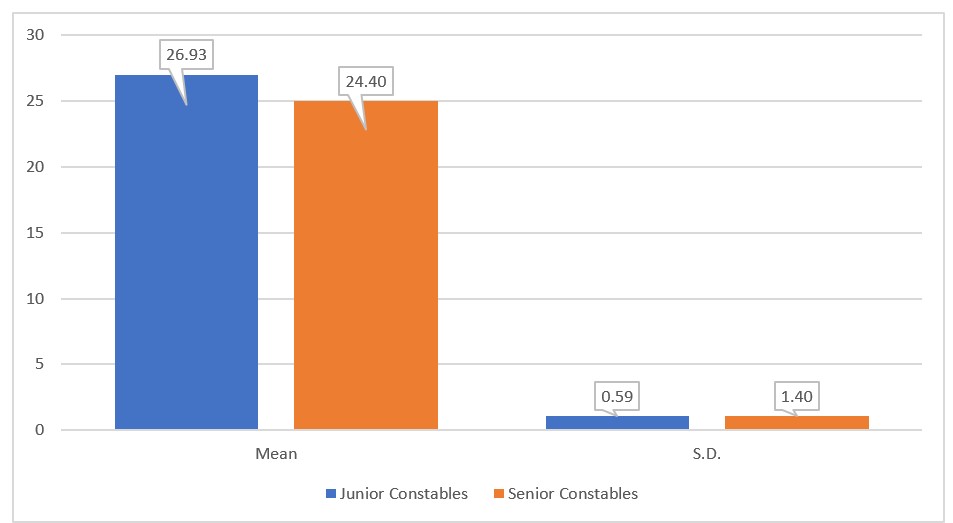Comparative Study on Selected Fitness and Body Care Status of Punjab Policewomen Constables
DOI:
https://doi.org/10.60081/SSHA.3.1(Spl).2025.465-468Keywords:
Health, Wellness, Women Constable, Fitness, Body CareAbstract
Aim of study: The aim of this study was to assess the status of health and wellness sub- parameter fitness and body care among Punjab Police women constables. Material and Methods: A sample of thirty (N=30) women constables from Punjab Police has been selected randomly and further bifurcated into two classes i.e., N1: Junior Constables with experience up to 1 year and N2: the Constables with the job up to 10 years Senior Constables, for the in-depth analysis. These two groups were also chosen through random sampling. The tool used for data collection was a structured ‘Wellness Questionnaire’ which was constructed by Gordon Edlin and Eric Golanty in 2004. The mean, S.D. and ‘t-test’ were calculated to find out the significance of difference between the groups. Results: mean and S.D. of Junior and Senior Punjab Police Women Constables for their Fitness and body care Variable is 26.93 ± 0.59 and 24.40 ± 1.40 respectively. The calculating ‘t’-value (1.718), which is less than the tabulated ‘t’-value (2.048), at 0.05 level. The calculated ‘t’-value (6.43), which is more than the tabulated ‘t’-value (2.048) at 0.05 level. Conclusion: So, it indicates that there is a significant difference between Junior and Senior Punjab Police Women Constables for their Fitness and body care Variable.
References
Balog, J.E. (1981). The concept of health and the role of health education. The Journal of School Health, 9, 462-464.
Chandler, C. K., Holden, J. M., & Kolander, C. A. (1999). Counseling for spiritual wellness: Theory and practice. Journal of Counseling and Development, 71, 168-175.
Dunn, H.L. (1961). High level wellness: Arlington, V. A: R.W. Beatty. As cited by Barbara J. Palombi. Journal of counseling and Development, 71(2), 221-225.
Edlin, G., & Golanty, E. (2015). Health and wellness (13th Ed.). Jones & Bartlett Publishers.
Eddin, G. and Golanty (1992). Health and wellness- a holistic approach. London: Jones and Bartlett Publisher.
Gul, Z., & Delice, M. (2011a). Police job stress and stress reduction/coping programs: the effects on the relationship with spouses. Turk J Police Stud, 13, 19–38.
Andrew, L. (1999, November 22). Wellness promotion: A people ready strategy. The Barbados Advocate, Business Monday, pp. 6-7.
World Health Organization. Strengthening Mental Health Promotion. Geneva, World Health (Fact sheet no. 220), 2001.
Parsons, J. R. (2004). 'Occupational Health and Safety Issues of Police Officers in Canada, the United States and Europe: A Review Essay'.
Reddy, S. (2008). Employee Health and Wellness Programs – Perspectives and Cases – pp 106-107.
Sharma, A., & Verma, S. (2019). Status of health and wellness among Chandigarh police male constables.
Singh, G., & Singh, A. (2018). Comparative study of fitness and body care status between teaching and non-teaching employees of Punjabi university Patiala.
Yadwinder Kaur, B. Singh and A. Singh (2023). “Emotional and environmental health of Punjab police women constables” IJEMS. 12(03):116-120

Downloads
Published
Issue
Section
License
Copyright (c) 2025 Bakhsis Singh

This work is licensed under a Creative Commons Attribution 4.0 International License.







